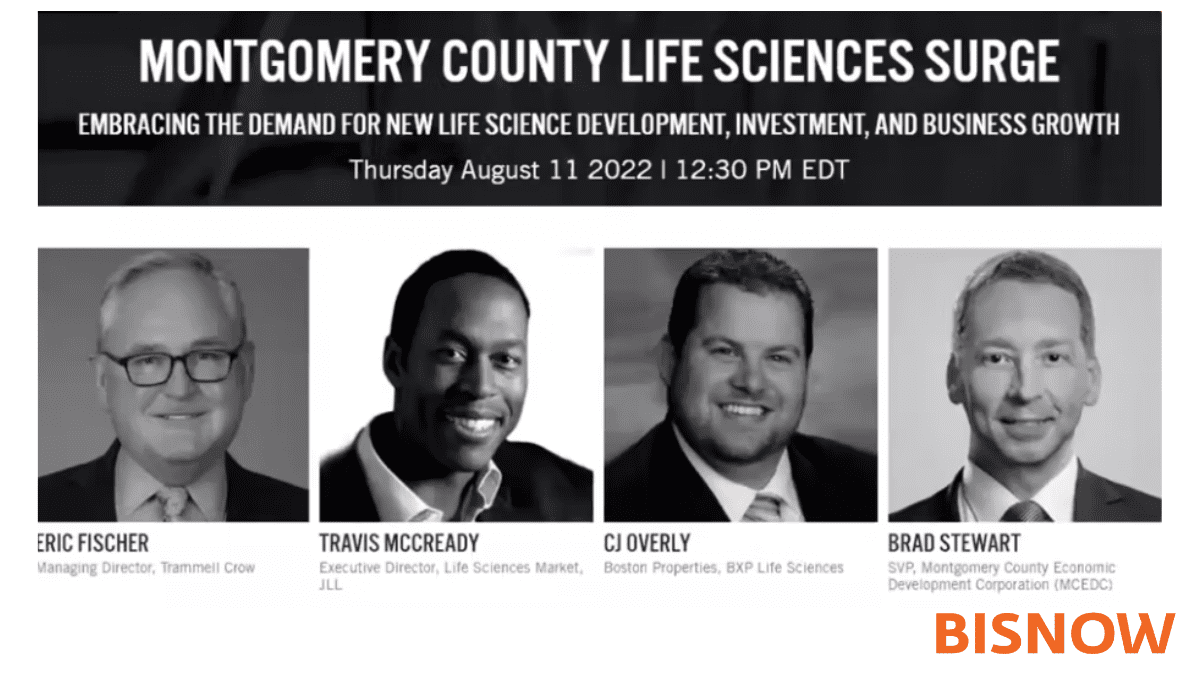
Montgomery County’s Life Science Ecosystem Continues to Surge Amidst Bear Market
Sponsored by ECBuild / EwingCole
Montgomery County has become a powerhouse in the life sciences space in the last decade. But real estate experts say it’s time to bring more venture capital into the area and capitalize on the state’s resources to keep the county’s momentum trending upward.
Bisnow recently held a webinar titled “Montgomery County Life Sciences Surge,” sponsored by the Montgomery County Economic Development Corporation (MCEDC), on August 11. Brad Stewart, Senior Vice President of Business Development at MCEDC, posed questions to real estate professional panelists about the future of Montgomery County’s life science environment.
Travis McCready, Executive Director of the life sciences market at JLL, compared the growth in Montgomery County to Massachusetts, which he helped promote at JLL as well. Similar to how Massachusetts promoted growth outside Cambridge and Boston, he believes growth will spill out of the county into other areas. One such area is Frederick County, where Kite Pharma, a Gilead company, opened a large facility last year.
To keep the growth in Montgomery County and Maryland going, McCready said the state has to keep its foot on the gas in terms of workforce development and financial support. One example of how the state has already done this is the Maryland Tech Council’s BioHub program, which promotes workforce training and collaboration with the state’s many universities.
RELATED: Kite Pharma is Leading the Charge in Sustainability
The development along the I-270 corridor has remained strong in recent years, with a decent amount of spec construction currently starting. CJ Overly, Senior Project Manager of Development at Boston Properties, and Eric Fischer, Managing Director at Trammell Crow shared their companies’ plans for large, urban-inspired campuses along the I-270 corridor.
Trammell Crow plans to break ground on a 500,000-square-foot life science campus in Frederick in October, which is set to include great amenities for users. Similarly, Boston Properties purchased the Shady Grove Bio+Tech Campus in Rockville last year and plans to convert it into a campus that feels more “urban in nature” than suburban, with easy transit access and amenities within walking distance.
Panelists agreed that access to these amenities has been crucial in the life science sector.
“What I love about CJ’s and Eric’s projects and how the life sciences sector as a whole is evolving,” said McCreary, “is it’s no longer about just scientists collaborating with one another, it’s about these really deep rich integrated places where scientists, engineers, and the community can connect interact with one another to create approaches, therapies, new business models and new movement that are effective and efficient for driving positive human health.”
Both Fischer and Overly discussed the importance of engineering spaces where organic connection can happen for employees, such as courtyards, walking paths, and even park space.
“It’s about the interconnection of pathways, getting people parked and off their bikes and having a bit of an experience as they come into their workplace,” said Fischer. “We’re ensuring we have amenities in place that are best in class within our region and within our ecosystem overall, that we have a higher level of amenity space for people to have casual conversations, to grab a coffee, a glass of wine, to have gyms that are not occupied to single occupiers but available for the entire campus.”
RELATED: Incubator “Cheat Sheet” for Life Science Entrepreneurs in the BioHealth Capital Region
Having many companies together in one biopark can also be attractive to families of scientists who might need more than one job opportunity in order to move to Maryland. And because companies are always coming and going, having other opportunities close by is a must for employees.
While the addition of new spec spaces is one great step forward for Montgomery County, the panelists agreed that companies and the county need to take advantage of the connections to academic and federal institutions to continue promoting growth.
“If you have the relationships with the centers and the professors that are at UMD, I think people appreciate just how world-class it is. But I still believe the UMD system is underrated and we can do a better job of presenting it as the world-class institution that it is,” said McCreary.
Overall, the panelists applauded the county’s international diversity and the growth of companies both local and foreign who have chosen to make Montgomery County their home.
“[Montgomery County] is at this really exciting tipping point of creating a diverse life sciences ecosystem that is multidisciplinary, multifunctional, and has the elements of suburban product which you’ve been very good at,” said McCreary. “But these new projects that CJ and Eric are leading will be world-class in being able to create that new [urban] type of environment. It’s exciting times for Montgomery County, and I for one am stoked about it.”
Discover the latest projects making an impact in the region and the companies building them. Click below…




